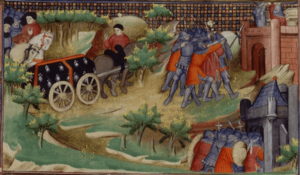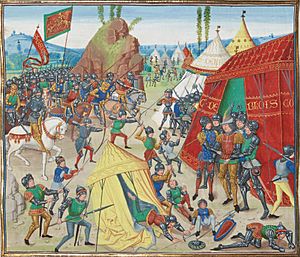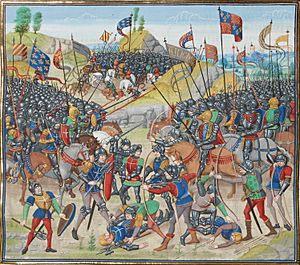War of the Breton Succession facts for kids
Quick facts for kids War of the Breton Succession |
|||||||
|---|---|---|---|---|---|---|---|
| Part of the Hundred Years' War | |||||||
 Battle of Auray |
|||||||
|
|||||||
| Belligerents | |||||||
|
|
||||||
| Commanders and leaders | |||||||
|
Joan of Penthièvre |
||||||
The War of the Breton Succession was a big fight in Brittany, France. It lasted from 1341 to 1365. Two powerful families, the Counts of Blois and the Montforts, fought over who should rule the Duchy of Brittany. A duchy was a territory ruled by a duke or duchess.
This war is also called the War of the Two Jeannes. This is because two important women named Jeanne (or Joanna) were involved. They were Joanna of Flanders and Jeanne de Penthièvre.
The War of the Breton Succession was part of the bigger Hundred Years' War between England and France. The French king supported the Blois family, while the English king backed the Montforts. This was because both kings wanted to choose who would rule Brittany.
Contents
Why the War Started
Brittany was a special place with links to both France and England. The Dukes of Brittany were also Earls in England.
The trouble began when Duke John III died in 1341. He had no children. Before he died, he didn't clearly name who should be the next duke.
There were two main people who thought they should rule:
- Joan of Penthièvre: She was John III's niece. She was married to Charles of Blois. Charles was also related to the King of France, Philip VI of France. Many nobles in Brittany supported them.
- John of Montfort: He was John III's half-brother. John III had tried to stop him from inheriting, but later changed his mind.
When John III died, both sides quickly tried to take control.
Early Battles and Leaders
John of Montfort acted fast. He took over Nantes, the main city, and seized the treasury. Soon, he controlled most of Brittany.
At first, this was a local problem. But then, the King of France heard that John of Montfort was talking to English agents. France was already fighting England in the Hundred Years' War. So, the French king decided to support Charles of Blois. This forced John of Montfort to ask for help from Edward III of England.
John of Montfort is Captured
In November 1341, John of Montfort was forced to give up Nantes. He was promised safety to talk with Charles of Blois, but instead, he was put in prison.
Now, John's wife, Joanna of Flanders, took charge of the Montfort side. She was a strong leader. She moved her base to Hennebont in western Brittany. Charles of Blois tried to capture her, but an English army arrived and helped her.
Fighting Continues
The English king, Edward III, arrived in Brittany in late 1342. He tried to capture Vannes. A new truce was signed in January 1343. Vannes was placed under the care of the Pope.
Even with the truce, fighting continued. Charles of Blois said he was fighting his own war, so he didn't have to follow the truce.
John of Montfort was released from prison in 1343. But his supporters were losing hope. In 1344, Charles of Blois captured Quimper. His army killed many people there, which made him very unpopular.
In 1345, John of Montfort escaped to England. He returned to Brittany with an English force. But he soon became sick and died on September 16, 1345. His young son, John, became the new leader of the Montfort cause.
The War Changes Course
Big events outside Brittany started to affect the war. The French army suffered major defeats against England in 1346 and 1347. Without French help, Charles of Blois began to lose ground. Many people in Brittany also wanted stronger trade links with England.
In 1347, Charles of Blois was captured by the English at the Battle of La Roche-Derrien. He was sent to the Tower of London for five years. The English now controlled important cities like Brest, Quimper, and Vannes.
The Combat of the Thirty
During this time, a famous event called the Combat of the Thirty happened. It was a duel between 30 Montfort knights and 30 knights supporting Charles of Blois. It took place on March 26, 1351. Even though it was a famous fight, it didn't change the outcome of the war.
In 1353, the English king tried to make a peace deal. He would accept Charles of Blois as Duke if Charles paid a lot of money and allied with England. Charles of Blois was freed and returned to Brittany.
The Final Stage of the War
The war continued with no clear winner for a while. Charles of Blois was the duke in practice, but the Montforts still held land.
In 1362, the younger John of Montfort (son of the first John) was old enough to lead. He returned to Brittany. He tried to make peace with Charles of Blois and share Brittany. But Charles's wife, Joan of Penthièvre, told him to keep fighting.
The war started again in 1363. Charles of Blois, helped by a famous French knight named Bertrand du Guesclin, had some success. But then, in 1364, John of Montfort and the English warlord John Chandos attacked Auray. Charles of Blois and Bertrand du Guesclin came to defend the city.
This led to the Battle of Auray on September 29, 1364. It was the last big battle of the war. Charles of Blois was killed, and Bertrand du Guesclin was captured. This battle ended the Blois family's claim to Brittany.
Peace and the Treaty of Guérande
Peace was finally made on April 12, 1365, with the First Treaty of Guérande. This treaty made John of Montfort the official Duke of Brittany.
The treaty also set rules for who would rule Brittany in the future:
- The Duchy would pass from father to son in the Montfort family.
- If there were no male Montfort heirs, it would go to the male heirs of the Penthièvre family.
- Joan of Penthièvre kept some of her lands and received money each year.
King Charles V of France accepted John as Duke. He was worried John might become loyal to the English king who had helped him. But John surprised everyone. In 1366, he promised his loyalty to the King of France, not England. This helped France and Brittany become friends.
Later, the Montfort family said the treaty was broken when a later Duke, John V, Duke of Brittany, was kidnapped by the Penthièvres. This led to new problems with who would rule Brittany.
Important Dates
- April 30, 1341 – Duke John III dies without children. The fight for who will rule Brittany begins between Joan of Penthièvre (and Charles of Blois) and John of Montfort.
- 1343 – John of Montfort is captured but later released. His wife, Joanna of Flanders, bravely defends Hennebont.
- 1344 – Charles of Blois captures Quimper and many people are killed.
- 1345 – John of Montfort dies. His young son, also named John, takes over the Montfort cause. His mother, Joanna of Flanders, leads the fight.
- 1346-1364 – Many small battles happen. Joanna of Flanders becomes ill and can no longer lead.
- March 27, 1351 – The famous Combat of the Thirty takes place.
- September 29, 1364 – The Battle of Auray ends the war. Charles of Blois is killed.
- 1365 – John IV is recognized as Duke of Brittany by the Treaty of Guérande. He surprisingly pledges loyalty to the King of France.
See also
- Duke of Brittany – Dukes of Brittany family tree
- Hundred Years' War





